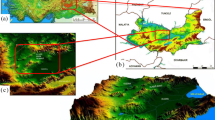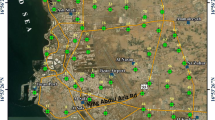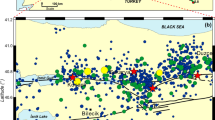Abstract
This paper presents the effects of geology and local soil conditions on the intensity of ground agitation with a moderate earthquake of magnitude Mw = 6.8 that struck Boumerdes, on May 21st 2003. The analysis of the earthquake response of the ground soil specific to the site of Zeralda, located west of Algiers was carried out. The first part consists in developing a database of the experimental site based on geophysical and geotechnical testing to estimate the local site conditions. In the second part, a numerical analysis is performed out using the FLAC2D software to evaluate the dynamic characteristics of the sand and consolidated sand, in particular the determination of the evolution curves of the shear modulus (G) and the damping (D) versus the shear strain (γ). The nonlinear model developed by Ramberg–Osgood and limited by the Mohr–Coulomb criterion is used. In the third part, the earthquake response from the ground surface was analyzed using the FLAC2D code, considering the nonlinear soil deposition behavior approach. The response spectrum resulting from this analysis of the nonlinear approach was compared with the response spectra of the Algerian seismic code (RPA 99, 2003) and Eurocode 8. A numerical evaluation of the G/Gmax(γ) and D(γ) curves of soil deposits seems to be compatible and close to other experimental data in the literature. The model presented by Ramberg–Osgood is applicable to the surface layer composed mainly of sand and consolidated sand. It therefore appears that the response spectrum was relatively underestimated by the Algerian building code, particularly during the short periods where the maximum spectral accelerations occur. The obtained results also validate the ability of the Ramberg–Osgood model to simulate the seismic response of the overburden to ground motions.


























Similar content being viewed by others
References
Bouhadad Y, Laouami N (2002) Earthquake hazard assessment in the Oran region (Northwest Algeria). Nat Hazards 26(3):227–243. https://doi.org/10.1023/A:1015602815231
Ayadi A, Bezzeghoud M (2014) Seismicity of Algeria from 1365 to 2013: maximum observed intensity map (MOI2014). Seismol Res Lett 86(1):236–244. https://doi.org/10.1785/0220140075
Atkison J and S Stallebrass (1991) Experimental determination of stress-strain-time characteristics in laboratory and in-situ tests. In: Proceedings, 10th European Conference on SMGE. Florence.
Mejia L and E Dawson (2006) Earthquake deconvolution for FLAC. In: 4th International FLAC symposium on numerical modeling in geomechanics. Citeseer.
Anastasiadis A, Senetakis K, Pitilakis K (2012) Small-strain shear modulus and damping ratio of sand-rubber and gravel-rubber mixtures. Geotech Geol Eng 30(2):363–382. https://doi.org/10.1007/s10706-011-9473-2
Khiatine M, Reiffsteck P, Bahar R (2019) Evaluation of dynamic soil properties for alluvial plain of Bejaia using field data and laboratory tests. Geotech Geol Eng 37:4707–4730. https://doi.org/10.1007/s10706-019-00933-x
Elia G, Rouainia M (2016) Investigating the cyclic behaviour of clays using a kinematic hardening soil model. Soil Dyn Earthq Eng 88:399–411. https://doi.org/10.1016/j.soildyn.2016.06.014
Bayat M, Ghalandarzadeh A (2017) Stiffness degradation and damping ratio of sand-gravel mixtures under saturated state. Int J Civ Eng. https://doi.org/10.1007/s40999-017-0274-8
Ishibashi I, Zhang X (1993) Unified dynamic shear moduli and damping ratios of sand and clay. Soils Found 33(1):182–191. https://doi.org/10.3208/sandf1972.33.182
Hardin BO, Drnevich VP (1972) Shear modulus and damping in soils: design equations and curves. J Soil Mech Found Div, ASCE 98:667–692
Seed H and I Idriss, (1970) Soil moduli and damping factors for dynamic re sponse. University of California, Berkeley, Rept, EERC-70–10
Braja M (1983) DA Fundamentals of soil dynamics, ed, Elsevier, Oxford, Amsterdam, New York
Pecker A, (1984) Dynamique des sols, presses de l’ENPC, Paris.
Verruijt A, (1996) Soil dynamics1996: Technische Universiteit, Faculteit Civiele Techniek.
Borel S, Reiffsteck P, (2006) Caractérisation de la déformabilité des sols au moyen d’essais en place. Etudes et recherches des Laboratoires des ponts et chaussées. Série Géotechnique
Kavazanjian E (1997). Geotechnical Engineering Circular No. 3: Design Guidance. Geotechnical Earthquake Engineering for Highways. Volume I-Design Principles
Motiani R, Vasanwala S, Thaker T (2021) Effect of site amplification on seismic fragility of RC building with different infill configurations using synthetic ground motions. Innovat Infrastruct Solut 6(3):1–19
Sil A, Haloi J (2018) Site-specific ground response analysis of a proposed bridge site over Barak River along Silchar Bypass Road. India Innovat Infrastruct Solut 3(1):1–19. https://doi.org/10.1007/s10706-007-9149-0
Borcherdt RD, Gibbs JF (1976) Effects of local geological conditions in the San Francisco Bay region on ground motions and the intensities of the 1906 earthquake. Bull Seismol Soc Am 66(2):467–500
Hough SE et al (2010) Localized damage caused by topographic amplification during the 2010 M 7.0 Haiti earthquake. Nat Geosci 3(11):778–782
Pitilakis K (2004) Site effects. Recent advances in earthquake geotechnical engineering and microzonation. Springer, Netherlands, Dordrecht, pp 139–197
Dixit J, Dewaikar D, Jangid R, (2012) Free field surface motion at different site types due to near-fault ground motions. Int Scholar Res Notices, 2012
Licata V et al (2019) A multi-level study for the seismic microzonation of the Western area of Naples (Italy). Bull Earthq Eng 17:4711–4741. https://doi.org/10.1007/s10518-019-00665-6
Finn WL and A Wightman, (2003) Ground motion amplification factors for the proposed 2005 edition of the National Building Code of Canada, Canadian J Civ Eng, 30(2): 272–278
Bard P-Y (2011) Seismic loading: engineering characterization of seismic ground motion and key controling factors. Eur J Environ Civ Eng 15(sup1):141–184. https://doi.org/10.1080/19648189.2011.9695307
Bard P-Y, Bouchon M (1980) The seismic response of sediment-filled valleys. Part 1. The case of incident SH waves. Bull Seismol Soc America 70(4):1263–1286
Athanasopoulos G, Pelekis P, Leonidou E (1999) Effects of surface topography on seismic ground response in the Egion (Greece) 15 June 1995 earthquake. Soil Dyn Earthq Eng 18(2):135–149
Kramer S (1996) Geotechnical earthquake engineering. Prentice Hall Inc, Upper Saddle River, NJ, p 653
Rayhani M, El Naggar M, Tabatabaei S (2008) Nonlinear analysis of local site effects on seismic ground response in the Bam earthquake. Geotech Geol Eng 26(1):91–100
Mucciarelli M, Gallipoli MR (2006) Comparison between Vs30 and other estimates of site amplification in Italy. In: First European Conference on Earthquake Engineering and Seismology
Castellaro S, Mulargia F, Rossi PL (2008) VS30: proxy for seismic amplification? Seismol Res Lett 79(4):540–543
Maouche S, Harbi A (2018) The active faults of the Mitidja basin (North Central Algeria): what does the seismic history of the region tell us? A review. Euro-Mediterranean J Environ Integrat 3(1):21. https://doi.org/10.1007/s41207-018-0061-1
RPA, Algerian Seismic Regulations, RPA 99 version 2003. National Earthquake Engineering Applied Research Center, CGS, Algeria, 2003.
AFPS, The earthquake of 21 May 2003 in Algeria, Report of the AFPS mission. Organised with the support of the Ministry of Ecology and Durable Development (MEDD/DPPR/SDPRM). 2003: p. 92.
CRAAG, (2003) La lettre du CRAAG, Numéro spécial Juille. 2003: p. 4.
Meghraoui M (2004) Coastal uplift and thrust faulting associated with the Mw = 6.8 Zemmouri (Algeria) earthquake of 21 May 2003. Geophys Res Lett 31(19):L19605. https://doi.org/10.1029/2004GL020466
Bozorgnia Y, Campbell KW (2004) The vertical-to-horizontal response spectral ratio and tentative procedures for developing simplified V/H and vertical design spectra. J Earthquake Eng 8(02):175–207. https://doi.org/10.1080/13632460409350486
Harbi A et al (2007) Seismicity, seismic input and site effects in the Sahel—Algiers region (North Algeria). Soil Dyn Earthq Eng 27(5):427–447. https://doi.org/10.1016/j.soildyn.2006.10.002
Sheet No 41, Published by the service of the geological map of Algeria. 1911.
Meyerhof G (1956) Penetration tests and bearing capacity of cohesionless soils. J Soil Mech Found Div 82(1):1–19
Casagrande A (1948) Classification and identification of soils. Trans Am Soc Civ Eng 113(1):901–930
Bagagli Y, Vincens E, Fry J-J (2010) A model for the computation of engineering earth structures to a seismic motion. Eur J Environ Civ Eng 14(5):599–616. https://doi.org/10.1007/BF02668848
Ramberg W, Osgood WR (1943) Description of stress-strain curves by three parameters. Nat Adv Committee Aeronaut, Tech Note 902:28
Pecker A, Dupas J-M (1981) Étude expérimentale du comportement d’une vase sous chargement cyclique. Rev Fr Géotech 15:59–73. https://doi.org/10.1051/geotech/1981015059
Khiatine M, et al. (2013) Evaluation of dynamics properties and liquefaction potentiel of silty sand in harbour of Bejaia, Algeria. in Proc. In: 2nd European Conf. on Earthquake Geotechnical Engineering and Seismology
Ray RP, Woods RD (1988) Modulus and damping due to uniform and variable cyclic loading. J Geotech Eng 114(8):861–876. https://doi.org/10.1061/(ASCE)0733-9410(1988)114:8(861)
Briaud J (1992) The Pressuremeter. published by AA Balkema. Rotterdam, Netherlands
Papadimitriou AG, Bouckovalas GD (2002) Plasticity model for sand under small and large cyclic strains: a multiaxial formulation. Soil Dyn Earthq Eng 22(3):191–204. https://doi.org/10.1016/j.soildyn.2010.04.001
Andrianopoulos KI, Papadimitriou AG, Bouckovalas GD (2010) Bounding surface plasticity model for the seismic liquefaction analysis of geostructures. Soil Dyn Earthq Eng 30(10):895–911. https://doi.org/10.1016/j.soildyn.2010.04.001
Szilvágyi Z, Ray RP (2018) Verification of the Ramberg-Osgood material model in Midas GTS NX with the modeling of torsional simple shear tests. Periodica Polytech Civ Eng 62(3):629–635. https://doi.org/10.3311/PPci.11191
Ahmad M, Ray R (2023) The dynamic properties of sand under torsion: a literature review. Geotechnics 3(2):480–514. https://doi.org/10.3390/geotechnics3020027
Ahmad M, Ray R (2021) Comparison between Ramberg–Osgood and Hardin-Drnevich soil models in Midas GTS NX. Pollack Periodica 16(3):52–57. https://doi.org/10.1556/606.2021.00353
Louadj S, Bahar R, Laouami N (2019) Numerical analysis of Keddara dam under seismic motion. Int J Eng Res Africa 40:47–62. https://doi.org/10.4028/www.scientific.net/jera.40.47
Park D, Kishida T (2019) Shear modulus reduction and damping ratio curves for earth core materials of dams. Can Geotech J 56(1):14–22. https://doi.org/10.1139/cgj-2017-0529
Benz T (2007) Small-strain stiffness of soils and its numerical consequences [PhD]. Institute of Geotechnical Engineering, University of Stuttgart, Stuttgart, Germany
Vucetic M, Dobry R (1991) Effect of soil plasticity on cyclic response. J Geotech Eng 117(1):89–107
Itasca Consulting Group, (2011) FLAC Fast Lagrangian Analysis of Continua and FLAC/Slope–User’s Manual.
Hashash Y, et al., (2020) «DEEPSOIL 7.0, User Manual». Urbana, IL, Board of Trustees of University of Illinois at Urbana-Champaign. 2020.
Stokoe K, et al (2004) Development of a new family of normalized modulus reduction and material damping curves. In: International Workshop on Uncertainties in Nonlinear Soil Properties and their Impact on Modeling Dynamic Soil Response. University of California at Berkeley Berkeley, California, USA
Darendeli MB (2001) Development of a new family of normalized modulus reduction and material damping curves. PhD thesis. University of Texas
Bedr S et al (2019) Investigation on shear modulus and damping ratio of Algiers marls under cyclic and dynamic loading conditions. Bull Eng Geol Env 78:2473–2493. https://doi.org/10.1007/s10064-018-1310-x
Elgamal A, Yang Z, Lu J (2006) Cyclic 1D: A computer program of seismic ground response, Department of Structural Engineering, University of California, San Diego. La Jolla, California, USA
Lu J (2006) Parallel finite element modeling of earthquake ground response and liquefaction: University of California, San Diego
Alipour A, Zareian F (2008) Study rayleigh damping in structures; uncertainties and treatments. In: The 14th world conference on earthquake engineering
Acknowledgements
The authors appreciate and acknowledge the help of the National Agency for the Management of the Realization of Major Cultural Projects (ARPC) and the assistance of the technical staff of the company construction and testing engineering laboratory (CTELAB), especially for making the data available for scientific use.
Author information
Authors and Affiliations
Corresponding author
Ethics declarations
Conflict of interests
The authors declare that they have no known competing financial interests or personal relationships that could have appeared to influence the work reported in this paper.
Ethical approval
All procedures performed in studies involving human participants were in accordance with the ethical standards of the institutional and national research committee, and this article does not contain any studies with human participants or animals performed by any of authors.
Informed consent
Formal consent is not required for this type of study.
Rights and permissions
Springer Nature or its licensor (e.g. a society or other partner) holds exclusive rights to this article under a publishing agreement with the author(s) or other rightsholder(s); author self-archiving of the accepted manuscript version of this article is solely governed by the terms of such publishing agreement and applicable law.
About this article
Cite this article
Khiatine, M., Bahar, R. Analysis of local site effects on seismic ground response under Boumerdes earthquake scenario: case study of Zeralda site of Algeria. Innov. Infrastruct. Solut. 9, 57 (2024). https://doi.org/10.1007/s41062-024-01368-x
Received:
Accepted:
Published:
DOI: https://doi.org/10.1007/s41062-024-01368-x




